2024
First aid
Primary study on the impact of recovery position on lower forearm perfusion
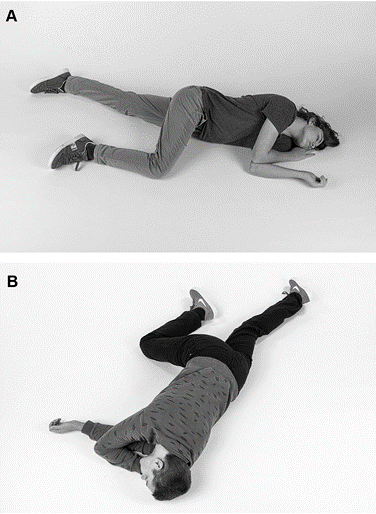 The International Liaison Committee on Resuscitation (ILCOR) recommends placing victims who are unresponsive but do not require cardiopulmonary resuscitation in a side-lying recovery position. High-certainty evidence regarding the optimal position is lacking, and in contrast to the 2015 guidelines, the 2021 European Resuscitation Council guidelines recommended that the lower arm should be stretched (see figure B) instead of bent (see figure A) because bending the arm might hinder blood flow. In the absence of evidence for this hypothesis, we conducted a cross-over randomized controlled trial in collaboration with the Antwerp University Hospital (UZA).
The International Liaison Committee on Resuscitation (ILCOR) recommends placing victims who are unresponsive but do not require cardiopulmonary resuscitation in a side-lying recovery position. High-certainty evidence regarding the optimal position is lacking, and in contrast to the 2015 guidelines, the 2021 European Resuscitation Council guidelines recommended that the lower arm should be stretched (see figure B) instead of bent (see figure A) because bending the arm might hinder blood flow. In the absence of evidence for this hypothesis, we conducted a cross-over randomized controlled trial in collaboration with the Antwerp University Hospital (UZA).
Eight healthy volunteers were placed in a lateral recovery position with either an extended or a bent lower arm, to assess the impact of position on perfusion of the lower forearm and associated comfort, pain, and skin discoloration. The results showed no significant differences in lower arm perfusion, oxygen saturation, heart rate, subjective pain, and discomfort between the two positions. However, there was slightly more skin discoloration in the extended arm position, contrary to the hypothesis that venous drainage might be compromised in the bent arm position. The study results allowed us to conclude that either position can be used effectively without compromising patient care or comfort, filling a gap in evidence and providing support for treatment recommendations regarding recovery positions in first-aid settings. The paper was published in Resuscitation Plus.
First aid blended learning study in Rwanda
From July 2023 to March 2024, CEBaP conducted a large-scale study on the effectiveness of blended learning in first aid training for adult laypeople in Rwanda, in collaboration with the International Cooperation Department of Belgian Red Cross and Rwanda Red Cross Society. Following an insightful pilot study, we enrolled a total of 540 participants, who were randomly assigned to one of three intervention groups: (1) a first aid training based on blended learning (e-learning plus one day of in-person training), (2) a conventional face-to-face training (three days), or (3) no training (waitlisted control group). Participants were assessed on their first aid-related knowledge, skills, attitudes, and helping behaviour before, immediately after, and six months after intervention. Data collection and analysis have been completed, and we are currently in the process of interpreting the results and preparing a manuscript for publication.
Update of first aid guidelines
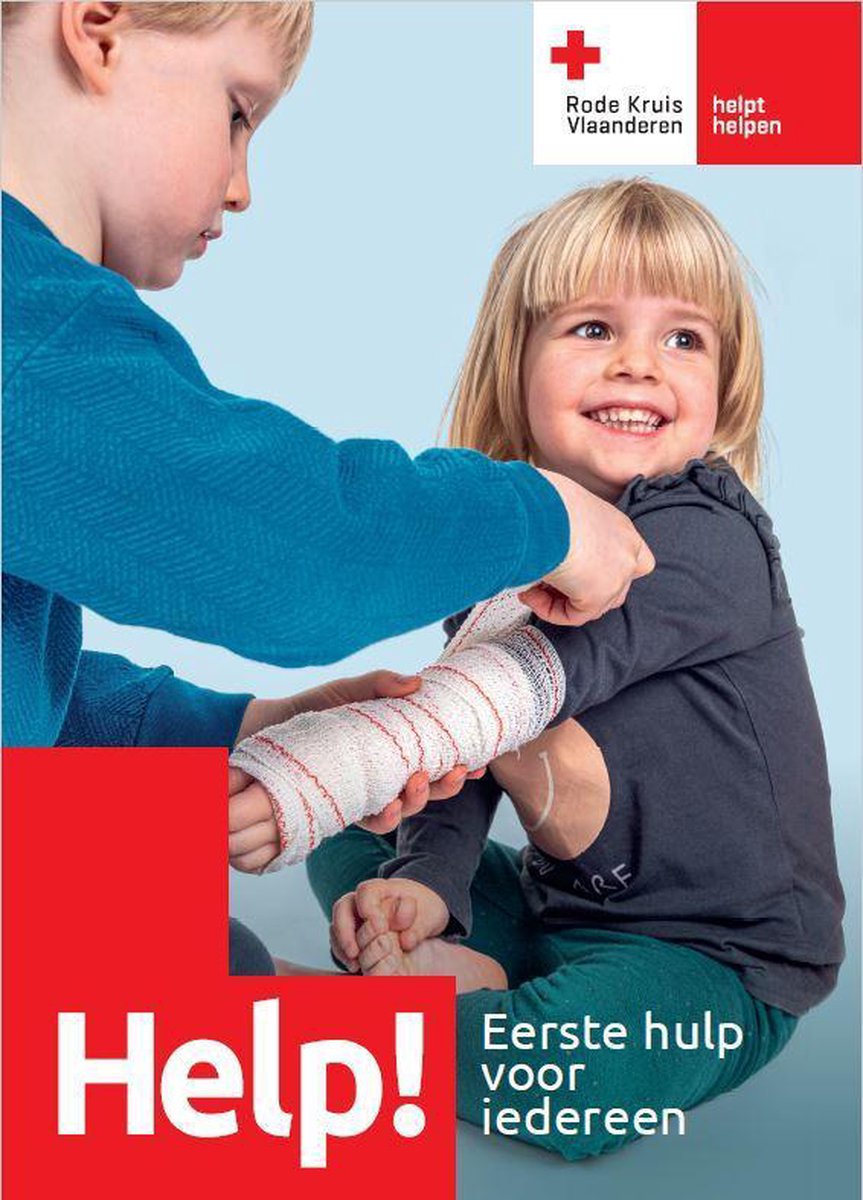 Every five years, CEBaP is involved in updating Belgian Red Cross’ evidence-based first aid guidelines for laypeople and the corresponding first aid manual Help! First aid for everyone [in Dutch: Help! Eerste hulp voor iedereen]. Throughout 2024, we updated two-thirds of the existing evidence summaries and developed several new ones based on the input of our colleagues at the First aid Department. In addition, we consulted the ILCOR Consensus on Science and Treatment Recommendations that were developed by the First Aid Task Force and the Adult Basic Life Support Task Force. Together, this will lead to the development of 334 evidence summaries by March 2025.
Every five years, CEBaP is involved in updating Belgian Red Cross’ evidence-based first aid guidelines for laypeople and the corresponding first aid manual Help! First aid for everyone [in Dutch: Help! Eerste hulp voor iedereen]. Throughout 2024, we updated two-thirds of the existing evidence summaries and developed several new ones based on the input of our colleagues at the First aid Department. In addition, we consulted the ILCOR Consensus on Science and Treatment Recommendations that were developed by the First Aid Task Force and the Adult Basic Life Support Task Force. Together, this will lead to the development of 334 evidence summaries by March 2025.
In addition, CEBaP is actively involved in developing the updated 2025 International First Aid, Resuscitation, and Education guidelines of the International Federation of Red Cross and Red Crescent Societies (IFRC). On top of taking part in the Steering Committee for these guidelines, CEBaP ensures the methodological quality of the guidelines and delivers most of the evidence to support the IFRC recommendations related to first aid.
Update of first aid for mental health problems
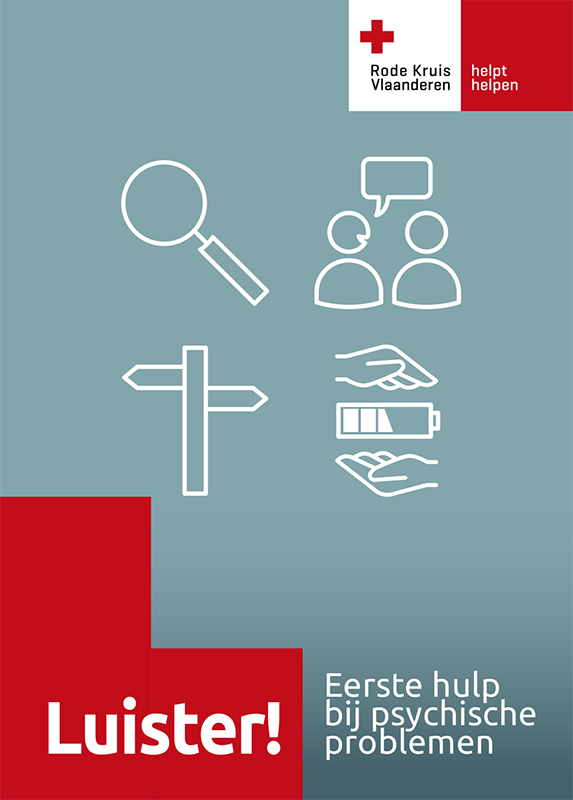 The first version of our evidence-based guidelines on first aid for mental health problems, covering topics such as addiction, burnout, depression, and grief, was published in 2019. The accompanying training manual, titled Listen! First aid for mental health problems [in Dutch: Luister! Eerste hulp bij psychische problemen], was launched alongside training sessions organised by Belgian Red Cross to better equip laypeople with the skills to assist people facing mental health challenges. In 2024, we updated these guidelines, which centre around forms of communication that laypeople can use to support individuals facing mental health issues.
The first version of our evidence-based guidelines on first aid for mental health problems, covering topics such as addiction, burnout, depression, and grief, was published in 2019. The accompanying training manual, titled Listen! First aid for mental health problems [in Dutch: Luister! Eerste hulp bij psychische problemen], was launched alongside training sessions organised by Belgian Red Cross to better equip laypeople with the skills to assist people facing mental health challenges. In 2024, we updated these guidelines, which centre around forms of communication that laypeople can use to support individuals facing mental health issues.
The update focused on the evidence related to aggression, burnout, psychosis, and traumatic events. Additionally, we introduced two new research questions: one on interventions to alleviate loneliness and another on the effectiveness of educational programmes in improving mental health-related first aid skills among laypeople. Our systematic search of the scientific literature yielded over 7000 records and led to the identification of 48 new publications, including 9 systematic reviews. Based on this work, the First Aid Department drafted revisions to the manual. This draft then underwent critical evaluation by an expert panel. By integrating the findings from the literature search and the expert panel’s insights, the guidelines were revised. The updated version of the handbook will become available in 2025.
First aid scoping and systematic reviews in collaboration with ILCOR
 Since 2013, CEBaP has regularly conducted systematic reviews and scoping reviews in collaboration with the ILCOR First Aid Task Force.
Since 2013, CEBaP has regularly conducted systematic reviews and scoping reviews in collaboration with the ILCOR First Aid Task Force.
In 2024, we led the development of a scoping review on spinal motion restriction for possible traumatic cervical spinal injury. A total of 66 studies were included: 46 experimental and 20 observational studies. The experimental studies primarily used human volunteers and human cadaver models to assess the range of cervical motion and the adverse effects of spinal motion restriction. The observational studies mainly investigated functional outcomes, adverse effects in trauma patients, and the risk of secondary spinal injury. The Task Force concluded that a systematic review is needed to update the current treatment recommendation, which suggests against the use of cervical collars by first aid providers.
In addition, we collaborated on a scoping review regarding the initial preservation of an amputated or avulsed body part. Based on evidence from 37 included studies, the ILCOR Task Force formulated two Good Practice Statements: a first one on retrieving and transporting the body part to a healthcare facility as soon as possible, and a second one on cooling the body part without freezing during retrieval and transportation.
Both scoping reviews will be published in the upcoming 2025 Consensus on Science and Treatment Recommendations publications.
Blood donation and transfusion
SUPPLY project: how often can plasma donors donate?
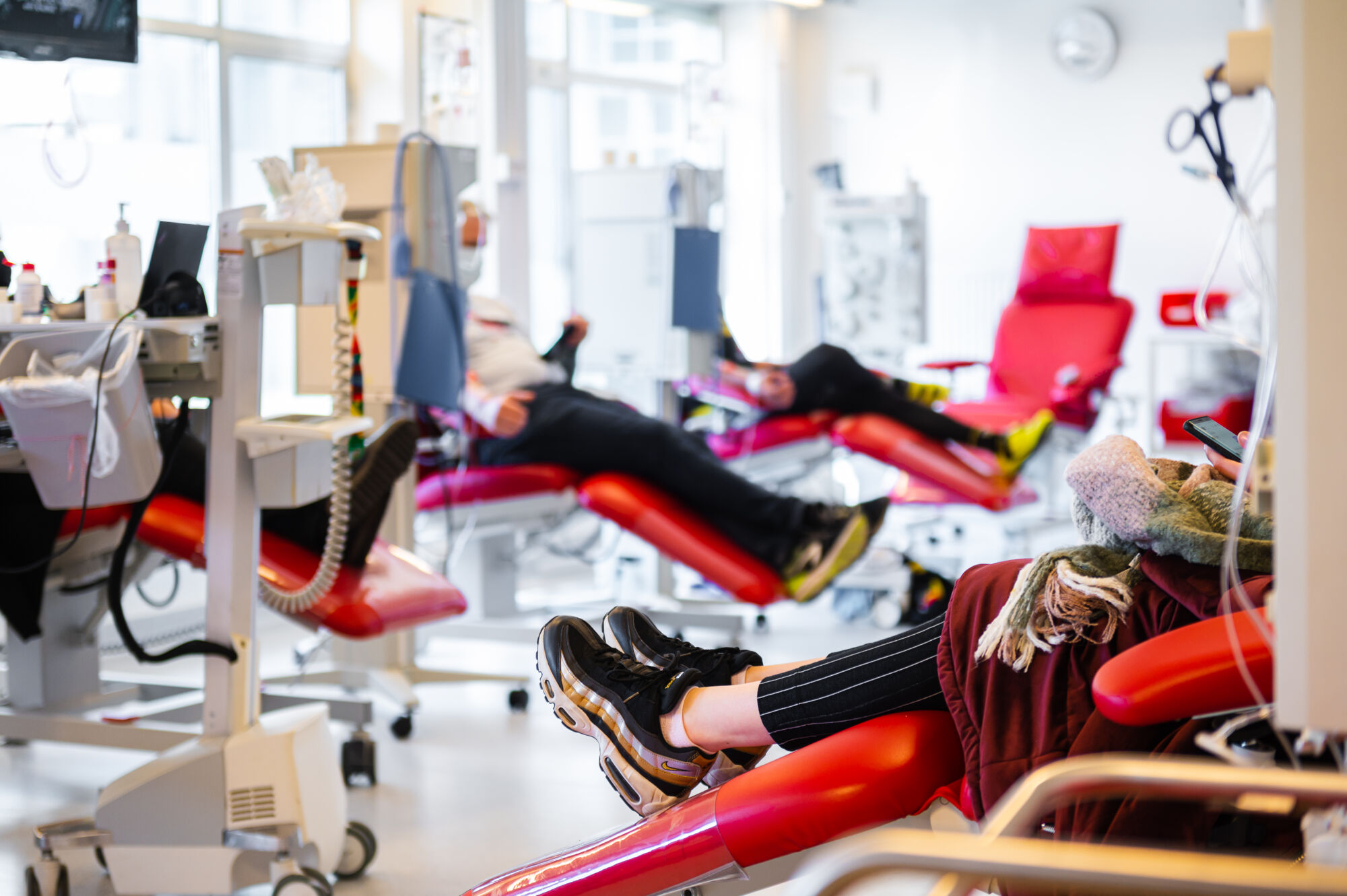 Plasma donations are crucial for producing life-saving medicines like immunoglobulins and clotting factors. While donors in the United States (US) can donate up to twice a week (i.e. 104 times annually), countries like Belgium limit donation frequency to once every two weeks.
Plasma donations are crucial for producing life-saving medicines like immunoglobulins and clotting factors. While donors in the United States (US) can donate up to twice a week (i.e. 104 times annually), countries like Belgium limit donation frequency to once every two weeks.
As part of the EU-funded SUPPLY project, we conducted a systematic review showing that high-frequency donations, such as those allowed in the US, may lower ferritin (iron storage) and IgG (immune function) levels, raising concerns about donor health. However, the evidence remains inconclusive due to small sample sizes and methodological limitations. We advocate for larger, high-quality studies to ensure safe donation frequencies while meeting the growing demand for plasma-derived medicines. Read the full review in Transfusion Medicine Reviews to learn more.
Hydrate to donate: simple strategies to prevent fainting in blood donors
Vasovagal reactions (VVRs), like dizziness and fainting, are common acute adverse events that may occur during or after blood donations. These reactions impact donor safety and can negatively affect donor retention. In 2024, we published a systematic review in Vox Sanguinis, which highlights simple, cost-effective nutritional strategies that can reduce these incidents in blood donors:

- Drink water before donation: consuming 250–500 mL of water pre-donation reduces on-site VVRs by 2 per 100 donors;
- Consume isotonic drinks and snacks: drinking 500 mL of isotonic beverages before donating, in combination with eating a post-donation snack, lowers off-site VVRs and fatigue;
- Take in caffeine or salt additives: the intake of water with caffeine or lemon water supplemented with salt may further reduce risks, though more research is needed.
These practices are easy to implement and significantly improve donor experience.
Factors influencing blood safety and donor retention in Tanzania: preliminary study results
Several regions in Tanzania currently do not collect sufficient blood donations to meet the demand. In addition, the share of voluntary unpaid blood donors is low, and retaining blood donors is difficult. Since there is limited scientific evidence on the factors influencing donor recruitment, retention, and blood safety in Tanzania, a cross-sectional study was set up by CEBaP and the International Department of Belgian Red Cross, in collaboration with the Tanzania Red Cross Society.
In 2023, questionnaires were administered to (candidate) donors during 43 mobile blood collections of the Tanzania Red Cross in five regions, resulting in 1471 data points. Participants were asked about their sociodemographic characteristics, donation history, motivating factors, received incentives, and the ways in which they were recruited. After adding test results for transfusion-transmitted infections, the dataset was anonymized and delivered to CEBaP.
Analyses performed in 2024 on a subset of 564 fully verified data points revealed four statistically significant predictors of donor deferral:
- Age: the younger the (candidate) donor, the higher the donor deferral rates;
- Reason for donating: deferral rates were higher in replacement donors, who donate blood for a family member or friend (either directly or indirectly), than in voluntary donors;
- Collection location: deferral rates were higher in public places than in schools/universities and in a refugee camp;
- Collection region: deferral rates were higher in Arusha, Kigoma, and Songwe, compared to Dar Es Salaam.
There were insufficient data points (n=418) to detect any statistically significant predictors of transfusion-transmitted infection positivity rates. Further analyses are ongoing.
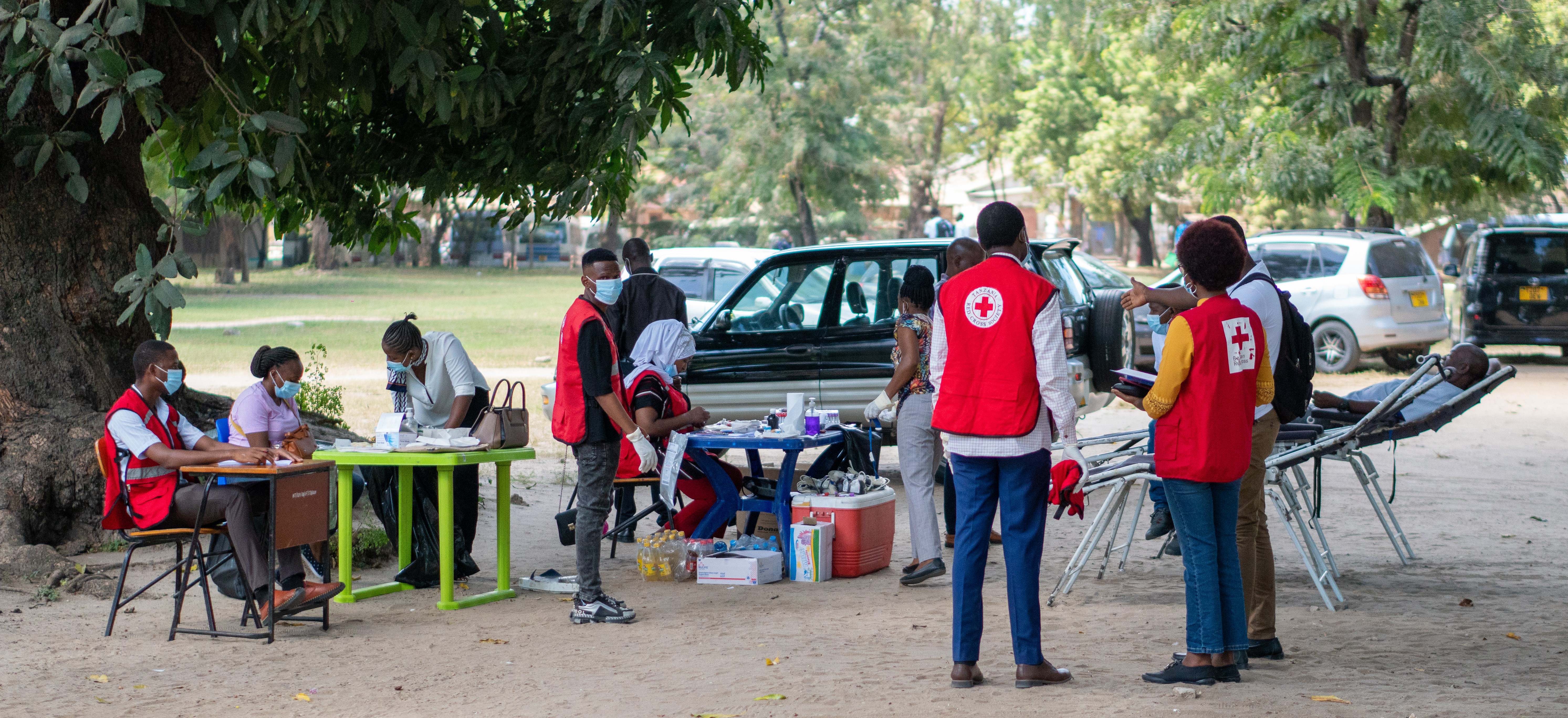
Social and psychosocial care
Updating the training manual on individual interventions for volunteers of the Social Intervention Service
 Volunteers of the Social Intervention Service (SIS) of Belgian Red Cross provide support to people, including fellow Belgian Red Cross volunteers, who have been exposed to a (potentially) traumatic event. This support is offered either individually, often via telephone, or in groups. Following the 2023 update of the training manual on group interventions, the manual used to train SIS volunteers in providing individual psychosocial support after a traumatic event was updated in 2024, with a specific focus on interventions delivered through telecommunication.
Volunteers of the Social Intervention Service (SIS) of Belgian Red Cross provide support to people, including fellow Belgian Red Cross volunteers, who have been exposed to a (potentially) traumatic event. This support is offered either individually, often via telephone, or in groups. Following the 2023 update of the training manual on group interventions, the manual used to train SIS volunteers in providing individual psychosocial support after a traumatic event was updated in 2024, with a specific focus on interventions delivered through telecommunication.
For this purpose, CEBaP systematically searched four databases to gather the best available evidence on the effectiveness of individual support via telecommunication. The search revealed only low to very low-certainty evidence, with no evidence regarding the efficacy and content of individual psychosocial support interventions delivered via telecommunication that were sufficiently comparable to the help provided by trained SIS volunteers. However, studies did suggest that there is no significant difference between professional individual psychological treatment offered via video or telephone compared to face-to-face delivery. The evidence was discussed by a multidisciplinary expert panel, which included academic experts, professional support workers, crisis helpline experts, psychologists, and SIS volunteers. In case of insufficient evidence, the panel formulated good practice points. Recommendations for providing effective individual psychosocial support via telephone were established and included in the updated manual.
